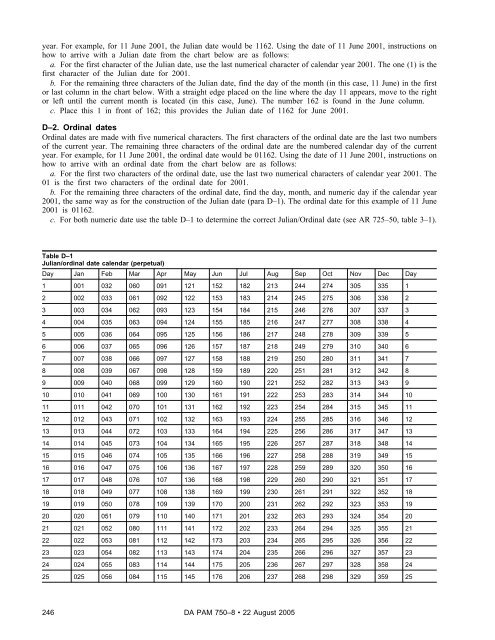The Army Maintenance Management System (TAMMS) Users Manual
The Army Maintenance Management System (TAMMS) Users Manual
The Army Maintenance Management System (TAMMS) Users Manual
You also want an ePaper? Increase the reach of your titles
YUMPU automatically turns print PDFs into web optimized ePapers that Google loves.
year. For example, for 11 June 2001, the Julian date would be 1162. Using the date of 11 June 2001, instructions on<br />
how to arrive with a Julian date from the chart below are as follows:<br />
a. For the first character of the Julian date, use the last numerical character of calendar year 2001. <strong>The</strong> one (1) is the<br />
first character of the Julian date for 2001.<br />
b. For the remaining three characters of the Julian date, find the day of the month (in this case, 11 June) in the first<br />
or last column in the chart below. With a straight edge placed on the line where the day 11 appears, move to the right<br />
or left until the current month is located (in this case, June). <strong>The</strong> number 162 is found in the June column.<br />
c. Place this 1 in front of 162; this provides the Julian date of 1162 for June 2001.<br />
D–2. Ordinal dates<br />
Ordinal dates are made with five numerical characters. <strong>The</strong> first characters of the ordinal date are the last two numbers<br />
of the current year. <strong>The</strong> remaining three characters of the ordinal date are the numbered calendar day of the current<br />
year. For example, for 11 June 2001, the ordinal date would be 01162. Using the date of 11 June 2001, instructions on<br />
how to arrive with an ordinal date from the chart below are as follows:<br />
a. For the first two characters of the ordinal date, use the last two numerical characters of calendar year 2001. <strong>The</strong><br />
01 is the first two characters of the ordinal date for 2001.<br />
b. For the remaining three characters of the ordinal date, find the day, month, and numeric day if the calendar year<br />
2001, the same way as for the construction of the Julian date (para D–1). <strong>The</strong> ordinal date for this example of 11 June<br />
2001 is 01162.<br />
c. For both numeric date use the table D–1 to determine the correct Julian/Ordinal date (see AR 725–50, table 3–1).<br />
Table D–1<br />
Julian/ordinal date calendar (perpetual)<br />
Day Jan Feb Mar Apr May Jun Jul Aug Sep Oct Nov Dec Day<br />
1 001 032 060 091 121 152 182 213 244 274 305 335 1<br />
2 002 033 061 092 122 153 183 214 245 275 306 336 2<br />
3 003 034 062 093 123 154 184 215 246 276 307 337 3<br />
4 004 035 063 094 124 155 185 216 247 277 308 338 4<br />
5 005 036 064 095 125 156 186 217 248 278 309 339 5<br />
6 006 037 065 096 126 157 187 218 249 279 310 340 6<br />
7 007 038 066 097 127 158 188 219 250 280 311 341 7<br />
8 008 039 067 098 128 159 189 220 251 281 312 342 8<br />
9 009 040 068 099 129 160 190 221 252 282 313 343 9<br />
10 010 041 069 100 130 161 191 222 253 283 314 344 10<br />
11 011 042 070 101 131 162 192 223 254 284 315 345 11<br />
12 012 043 071 102 132 163 193 224 255 285 316 346 12<br />
13 013 044 072 103 133 164 194 225 256 286 317 347 13<br />
14 014 045 073 104 134 165 195 226 257 287 318 348 14<br />
15 015 046 074 105 135 166 196 227 258 288 319 349 15<br />
16 016 047 075 106 136 167 197 228 259 289 320 350 16<br />
17 017 048 076 107 136 168 198 229 260 290 321 351 17<br />
18 018 049 077 108 138 169 199 230 261 291 322 352 18<br />
19 019 050 078 109 139 170 200 231 262 292 323 353 19<br />
20 020 051 079 110 140 171 201 232 263 293 324 354 20<br />
21 021 052 080 111 141 172 202 233 264 294 325 355 21<br />
22 022 053 081 112 142 173 203 234 265 295 326 356 22<br />
23 023 054 082 113 143 174 204 235 266 296 327 357 23<br />
24 024 055 083 114 144 175 205 236 267 297 328 358 24<br />
25 025 056 084 115 145 176 206 237 268 298 329 359 25<br />
246 DA PAM 750–8 22 August 2005

















